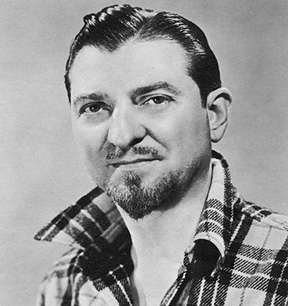
Jon GnagyJon Gnagy, known to millions as America's television art teacher, was born at Varner's Forge, an outpost settlement near Pretty Prairie Kansas in 1907. The pioneer environment of his first seven years at the Forge and family farm reflect a strong influence in his work as an artist. Son of Hungarian-Swiss Mennonites, Jon early developed inventive skills common to rural craftsmen. At the age of eleven he began drawing and painting without instruction, winning sweepstake prizes at the Kansas State Fair in Hutchinson when he was thirteen years old. Gaining attention each year at the State Fair as the self-taught "blacksmith" of art, his vigorous compositions of the American Scene brought him an offer from Tulsa, Oklahoma. When he was seventeen he accepted the position of art director with an industrial public relations organization in the Oil Capital, where he produced posters for the International Petroleum Exposition. Winning national awards in poster competitions, he went on to further offers, moving his young family to Wichita where he studied aerodynamics and collaborated in designing the first low wing monoplane built in America. Also during his several years work in Wichita he wrote and illustrated the advertising for the aircraft companies (including Cessna, Stearman and Beechcraft who are still dominant in the aircraft industry). When the depression hit, Gnagy headed for Kansas City where he worked for a year and had his first opportunity to look in on the resources of an art school, at the Kansas City Art Institute evening classes. The stimulating experience of seeing other artists at work and listening to their philosophy of art whetted his appetite for more. Determined to hit the "big time" or "bust" he bundled his wife and daughter off to New York at the age of 24. The depression in the big city was far worse than in the West but with twenty four dollars left in his wallet he took a room at the YMCA, wheedled desk space with two starving commercial artists in the Salmon Tower at 5th Avenue at 42nd Street and went looking for free-lance work. The second day on the shoe-leather beat he landed one of the juiciest assignments of an artist's dream; several full page layouts and the finished art contract on three full page ads for the Aluminum Company of America to run in the Saturday Evening Post and Fortune Magazine. Jon's studio associates called his break "sheer luck." Jon calls it "ignorant nerve plus enthusiasm," and he always considered enthusiasm the most irresistible power in the world; translated from Greek it means "the God within you." With the first blush of success Jon and his wife and daughter joined him and they moved to Pelham but soon discovered they couldn't afford the commuters luxuries on the spotty income of a freelance designer during the depression. From Pelham the Gnagys moved to economy quarters over a steam laundry in Flushing, Long Island, where their son Steve was born. From feast to famine and back to feast again; an offer of a job as assistant art director came from Philadelphia. The move was made, the work and pay was good and soon the Gnagy family moved to the growing art colony of New Hope, Pennsylvania, where Jon could mingle with other artists and study for three hours a day on the commuter train. During the next eighteen years the smoking car of that little train was Jon's study hall. Reading every book on art and philosophy and joining interesting discussions with famous artists, authors, playwrights and composers in the Bucks County Genius Belt gave him better than art school or college education. The war activity stimulated extracurricular jobs such as teaching and training hundreds of volunteers in preparing camouflage exhibits for the National Camouflage Exhibit at the Franklin Institute under the auspices of the Fourth Army District of the U.S. Also he served as Art Director for the War Service Committee which produced poster designs for the war plants throughout the heavily concentrated industrial area of the eastern Seaboard. The experience gained in handling such group training led to a demand for Jon Gnagy's lecture demonstrations on The Science of Color Harmony and the Psychology of Color Vision. Even though he had no college degree he was booked for lecture demonstrations to the most famous Academies of art and science and State Teachers' Colleges from Richmond to Rochester. Through these activities Gnagy became well prepared for his role as one of the country's greatest audio-visual educators when television started beaming to the public on May 13th, 1946. His was the first performer on the first show the day the antenna was completed atop the Empire State Building. Since then the grassroots blacksmith's name has become a household friend to millions of people. Click HERE for information on Jon Gnagy's "Learn to Draw" kits. |